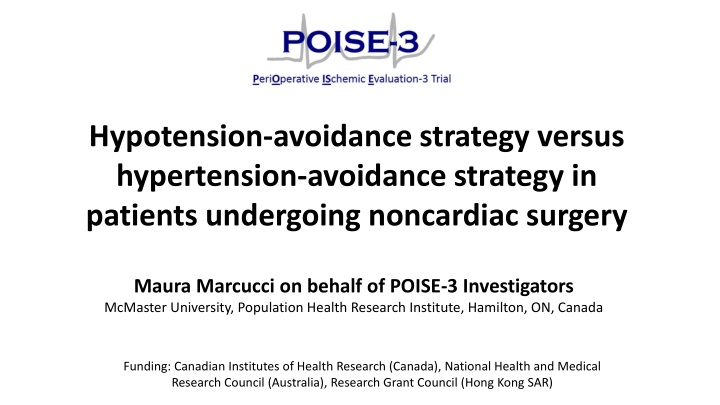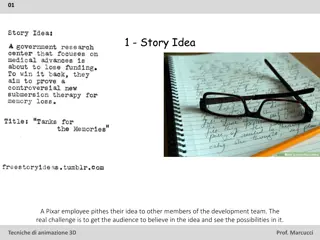
Perioperative Blood Pressure Management in Noncardiac Surgery Patients
Explore the impact of perioperative hypotension-avoidance strategy versus hypertension-avoidance strategy on major vascular complications in patients undergoing noncardiac surgery. This study aims to assess the effects of different blood pressure management approaches in reducing the incidence of vascular events within 30 days post-surgery. The research involves a large-scale trial with specific eligibility criteria and a 2x2 factorial design.
Download Presentation

Please find below an Image/Link to download the presentation.
The content on the website is provided AS IS for your information and personal use only. It may not be sold, licensed, or shared on other websites without obtaining consent from the author. If you encounter any issues during the download, it is possible that the publisher has removed the file from their server.
You are allowed to download the files provided on this website for personal or commercial use, subject to the condition that they are used lawfully. All files are the property of their respective owners.
The content on the website is provided AS IS for your information and personal use only. It may not be sold, licensed, or shared on other websites without obtaining consent from the author.
E N D
Presentation Transcript
Hypotension-avoidance strategy versus hypertension-avoidance strategy in patients undergoing noncardiac surgery Maura Marcucci on behalf of POISE-3 Investigators McMaster University, Population Health Research Institute, Hamilton, ON, Canada Funding: Canadian Institutes of Health Research (Canada), National Health and Medical Research Council (Australia), Research Grant Council (Hong Kong SAR)
Background >300 millions/year adult noncardiac surgeries Major vascular complications frequent Hemodynamics abnormalities frequent >25% intraoperative and/or postoperative hypotension linked to major vascular complications >50% take chronic antihypertensive medications commonly continued perioperatively (although practice varies)
Rationale Observational studies and small RCTs suggest withholding ACEIs/ARBs may reduce perioperative hypotension and vascular complications Observational studies suggest withholding beta-blockers may increase perioperative vascular complications Intraoperative mean arterial pressure (MAP) targets 60 mm Hg are commonly used however, based on observational data, it has been questioned whether MAP targets 80 mm Hg would improve outcomes Uncertainty remains regarding optimal perioperative blood pressure management
Research question In patients undergoing noncardiac surgery who are at risk of vascular events what are effects of perioperative hypotension-avoidance strategy versus hypertension-avoidance strategy on 30-day incidence of major vascular complications?
Design Partial 2x2 factorial design 10,000 patients in tranexamic acid or placebo trial Expected 6,500 patients in blood pressure trial Patients, healthcare providers, and study personnel aware of blood pressure treatment assignment Outcome adjudicators masked to treatment assignment
Eligibility criteria Included patients 45 years old, undergoing inpatient noncardiac surgery at risk of perioperative cardiovascular events chronically taking 1 antihypertensive medication Excluded patients NYHA class III-IV, or LVEF 30%; hemodynamically unstable cranial neurosurgery hypertension-related cerebral hemorrhage, thyrotoxicosis, pheochromocytoma
Intervention Patients told not to take antihypertensive medications night before and morning of surgery bring medications to preoperative holding area hypotension-avoidance vs hypertension-avoidance based on blood pressure abnormality preferentially intended to avoid
Hypotension-avoidance strategy Preoperative management chronic antihypertensive medications based on algorithm Intraoperative management target MAP 80 mm Hg Postoperative management day 0-2 chronic antihypertensive medications based on algorithm
Hypertension-avoidance strategy Preoperative management given chronic antihypertensive medications Intraoperative management target MAP 60 mm Hg Postoperative management restart chronic antihypertensive medications after surgery
Primary outcome Major vascular complication composite of vascular death and nonfatal myocardial injury after noncardiac surgery (MINS), stroke, and cardiac arrest
Patients randomized and follow-up 7490 randomized in blood pressure trial 3742 hypotension-avoidance 3748 hypertension-avoidance Follow-up troponin on first 3 days after surgery study personnel followed patients throughout hospitalization and contacted patients at 30 days >99% of participants completed 30-day follow-up
Baseline characteristics Hypotension-avoidance (N = 3742) Hypertension-avoidance (N = 3748) age, years male 70 70 2075 (56%) 2096 (56%) number of chronic antihypertensive meds mean (sd) 3 meds 2 (1) 2 (1) 1038 (28%) 2684 (72%) 1011 (27%) 2684 (72%) chronic ACEI or ARB chronic beta-blocker 1668 (45%) 1601 (43%)
Intraoperative compliance Hypotension- avoidance (N = 3742) Hypertension- avoidance (N = 3748) Median difference (95% CI) Intraoperative MAPs Minutes, median (IRQ)* MAP <60 0 (0 - 0) 0 (0 - 2) NA MAP 60-79 25 (5 - 63) 56 (20 - 108) -31 (-34 to -28) MAP 80 101 (55 - 165) 70 (26 - 125) 31 (27 to 36) *mean duration of surgery 170 minutes
Pre- and postoperative compliance Hypotension-avoidance (N = 3742) Hypertension-avoidance (N = 3748) Day % compliance (95% CI) Day of Surgery* 68 (67 - 70) 57 (55 - 58) Postoperative day 1 75 (73 - 76) 67 (65 - 68) Postoperative day 2 72 (71 - 74) 70 (69 - 72) *before and after surgery
Medications received perioperatively Day of surgery Day 1 after surgery Day 2 after surgery Hypo Hyper Hypo Hyper Hypo Hyper % received ACEI/ARB % received beta- blocker % received 1 antihypertensive 5 38 6 47 7 50 23 32 25 36 28 37 36 70 39 79 42 83 Hypo = hypotension-avoidance Hyper = hypertension-avoidance
Primary outcome Hypotension- avoidance N = 3742 n (%) Hypertension- avoidance N = 3748 n (%) Hazard ratio (95% CI) P value Major vascular complication 520 (13.9) 524 (14.0) 0.99 (0.88-1.12) 0.92 Results not modified by status of randomization to tranexamic acid or placebo group (interaction P=0.54)
Secondary outcomes Hypotension- avoidance N = 3742 n (%) Hypertension- avoidance N = 3748 n (%) Hazard ratio (95% CI) P value Myocardial injury after noncardiac surgery (MINS) MINS not fulfilling universal definition of MI 474 (12.7) 481 (12.8) 0.99 (0.87-1.12) 0.84 424 (11.3) 439 (11.7) 0.97 (0.85-1.10) 0.61 Myocardial infarction 54 (1.4) 46 (1.2) 1.18 (0.80-1.75) 0.41 Stroke 17 (0.5) 17 (0.5) 1.00 (0.51-1.96) >0.99 Vascular mortality 25 (0.7) 24 (0.6) 1.04 (0.60-1.83) 0.88 All-cause mortality 50 (1.3) 43 (1.1) 1.17 (0.78-1.75) 0.46
Tertiary outcomes Hypotension- avoidance N = 3742 n (%) Hypertension- avoidance N = 3748 n (%) Hazard ratio (95% CI) P value Non-fatal cardiac arrest 7 (0.2) 3 (<0.1) 2.34 (0.60-9.04) 0.22 Hemorrhagic stroke 0 (0.0) 1 (<0.1) - - Non-hemorrhagic stroke 17 (0.5) 16 (0.4) 1.07 (0.54-2.11) 0.86 Acute congestive heart failure 21 (0.6) 18 (0.5) 1.17 (0.62-2.19) 0.63 New clinically important AF 62 (1.7) 44 (1.2) 1.42 (0.96-2.08) 0.08 Sepsis 47 (1.3) 57 (1.5) 0.88 (0.60-1.29) 0.51
Other tertiary outcomes Hypotension- avoidance N = 3742 median days (IRQ) Hypertension- avoidance N = 3748 median days (IRQ) Median difference (95% CI) P value Length of hospital stay 4.0 (2.1-7.1) 4.0 (2.1-7.0) 0.05 (-0.05, 0.14) 0.34 Days alive and at home 25.0 (21.0-28.0) 25.0 (21.0-28.0) >-0.01 (-0.29, 0.29) 1.00
Effects on hemodynamics Hypotension- avoidance mean Hypertension- avoidance mean Mean difference (95% CI) Post-randomization time Systolic blood pressure, mm Hg 147.5 146.5 132.5 131.3 132.1 130.4 129.0 127.4 131.8 130.7 Heart rate, bpm 75.4 74.8 76.0 74.7 76.6 75.2 77.0 75.8 78.7 77.3 before anesthetic induction in PACU (2 hrs from surgery) upon arrival to surgical ward day 1 after surgery day 2 after surgery 1.0 (0.0, 2.0) 1.2 (0.1, 2.3) 1.7 (0.7, 2.7) 1.6 (0.8, 2.4) 1.1 (0.2, 2.0) before anesthetic induction in PACU (2 hrs from surgery) upon arrival to surgical ward day 1 after surgery day 2 after surgery 0.6 (0.0, 1.2) 1.3 (0.5, 2.1) 1.4 (0.7, 2.1) 1.2 (0.6, 1.8) 1.4 (0.7, 2.1)
Effects on hemodynamics by centre compliance Effects of blood pressure strategies on hemodynamics consistent across centres with different compliance Interaction P=0.72 for systolic blood pressure Interaction P=0.15 for heart rate
Conclusions Perioperative hypotension-avoidance strategy did not differ from hypertension-avoidance strategy regarding effects on 30-day major vascular complications
Implications POISE-3 informs questions that commonly confront physicians taking care of patients undergoing surgery during surgery: target MAPs 60 or 80 produced similar vascular outcomes perioperatively: holding ACEI/ARBs and continuing other chronic antihypertensive meds based on blood pressure, versus continuing all antihypertensive meds, resulted in no substantial impact on hemodynamics and vascular outcomes Further research is needed to evaluate perioperative interventions that can modify hemodynamics to extent and in direction that will lead to favorable impact on clinical outcomes



